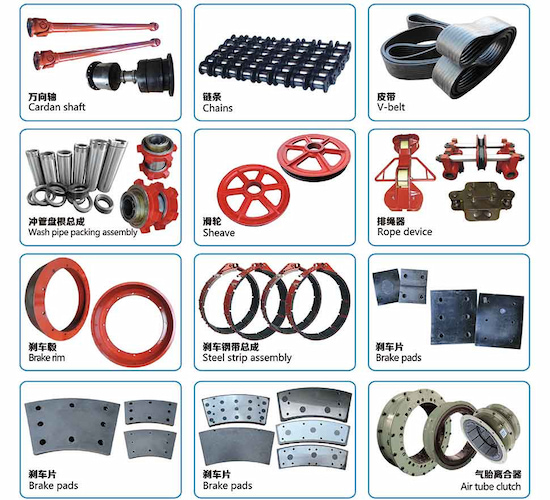Что представляет собой система трансмиссии буровой установки?
Oct 22, 2025
Ⅰ. Основные компоненты и функции1. ДвигательОсновная роль: Являясь первичным источником энергии трансмиссионной системы, он вырабатывает механическую энергию посредством сгорания топлива или электропривода и напрямую соединяется с приводным валом через выходной вал, запуская всю цепочку трансмиссии.Применимые сценарии: В буровых установках с механическим приводом или гибридных буровых установках чаще всего используется дизельный двигатель (например, V-образный 12-цилиндровый четырехтактный дизельный двигатель); в буровых установках с электрическим приводом он может быть заменен электродвигателем для непосредственной передачи мощности на приводной вал.2. Приводной валОсновная роль: Жесткий/гибкий вал (в основном, конструкция из полой стальной трубы, длина которой подбирается в зависимости от компоновки оборудования), соединяющий двигатель и редуктор. Он обеспечивает бесперебойную передачу механической энергии от двигателя к редуктору, компенсируя при этом незначительные вибрации и смещения во время работы оборудования (компенсируя угловые отклонения посредством карданных шарниров).Технические характеристики: Он должен обладать высокой грузоподъёмностью (обычно ≥5000 Н·м) и усталостной прочностью. Его поверхность подвергается термообработке для повышения износостойкости и предотвращения разрушения при длительном вращении с высокой скоростью.3. Коробка передачОсновная роль: Благодаря внутреннему зацеплению шестерен он преобразует высокоскоростную мощность с низким крутящим моментом, подаваемую приводным валом, в низкоскоростную мощность с высоким крутящим моментом (например, при движении сверло) или средней скорости, средней мощности крутящего момента (например, при движении лебедки), отвечающие требованиям к условиям работы различного оборудования.Ключевые функцииРегулировка переключения передач: реализует многоступенчатое переключение скорости/крутящего момента посредством гидравлического или механического переключения (например, использование пониженной передачи во время бурения для увеличения усилия разрушения породы долотом и повышенной передачи во время спускоподъемных операций для повышения эффективности);Реверсивная передача: некоторые редукторы поддерживают обратную передачу мощности (например, когда лебедка опускает бурильную колонну, обратные передачи используются для торможения и замедления).4. ЦепьОсновная роль: Соединяет выходной конец редуктора с механизмом привода долота (например, поворотный стол, верхний привод). Благодаря зацеплению цепи и звездочки регулируемая мощность передается от редуктора к буровому долоту, заставляя его вращаться и разрушать породу.Технические преимуществаВысокая передача крутящего момента (одна цепь может выдерживать крутящий момент 1000–3000 Н·м), что подходит для работ с высокими нагрузками на буровое долото, например, при разрушении твердых пород;Высокая эффективность передачи при минимальных потерях энергии, простая конструкция и низкие затраты на обслуживание.Применимые сценарии: Трансмиссия ротора наземных буровых установок и силовая передача систем верхнего привода.5. РеменьОсновная роль: Благодаря трению между шкивами и ремнями он распределяет и передает мощность от редуктора к лебедке (для спуска бурильной колонны) и буровой насос для буровой установки (для циркуляции бурового раствора).Технические характеристикиГибкая трансмиссия: может смягчать удары мощности, уменьшая износ коробки передач;Низкая стоимость и простота замены: по сравнению с цепями ремни легче и тише, подходят для условий средней и низкой нагрузки.Ограничения: ограниченная передача крутящего момента (обычно ≤1000 Н·м), склонность к проскальзыванию при длительных высоких нагрузках, необходимость регулярной регулировки натяжения.6. Гидравлический двигательОсновная роль: Преобразует энергию давления гидравлической системы в механическую энергию для независимого привода бурового долота, лебедки или бурового насоса.Технические преимуществаШирокий диапазон регулирования скорости: плавное регулирование скорости 0–3000 об/мин может быть достигнуто путем регулирования расхода гидравлического масла (например, регулировка скорости долота в реальном времени в соответствии с твердостью пласта);Надежная защита от перегрузки: гидравлическая система оснащена перепускным клапаном, который автоматически сбрасывает давление при перегрузке, чтобы избежать повреждения оборудования (например, защищая долото и двигатель при застревании трубы);Гибкая компоновка: не требуется жесткого соединения, что позволяет перемещать оборудование на большие расстояния по гидравлическим трубопроводам (например, буровые насосы вдали от кабины электростанции на морских буровых установках).Типичные области применения: Точная регулировка верхних приводов в автоматизированных буровых установках, стабильная работа лебедок и привод бурового насоса в малых установка для капитального ремонта скважинs.Ⅱ. Рабочий процесс системы передачиВыходной каскад мощности: Двигатель или мотор запускается, выдает механическую энергию на приводной вал, а приводной вал стабильно передает мощность на коробку передач, компенсируя угловые отклонения через карданные шарниры.Стадия регулирования параметров: Редуктор переключается в соответствии с эксплуатационными требованиями (например, бурение/спускоподъемные работы), регулируя скорость и крутящий момент.Стадия перенаправления мощности:Высокий крутящий момент от редуктора передается на приводной механизм долота (роторный стол или верхний привод) через цепь, заставляя долото вращаться и разрушать породу;Мощность среднего крутящего момента передается на лебедку и буровой насос через ремень;The гидравлический двигатель независимо получает мощность от гидравлической системы для вспомогательного привода долота, лебедки или бурового насоса.Ⅲ. Основные технические требования и пункты обслуживания1. Технические требованияСоответствие: компоненты должны быть адаптированы в соответствии с «цепочкой параметров мощности» (например, выходной крутящий момент двигателя ≥ грузоподъемности приводного вала, диапазон регулировки коробки передач охватывает требования к оборудованию), чтобы избежать перегрузки;Надежность: в условиях высоких температур и влажности цепи/ремни должны быть устойчивы к ржавчине, гидравлические двигатели должны быть герметичными, а в редукторах должно использоваться термостойкое трансмиссионное масло.2. Точки технического обслуживанияЦепи/ремни: еженедельно проверяйте натяжение; ежемесячно смазывайте цепи и очищайте шкивы;Коробка передач: заменяйте трансмиссионное масло каждые 500 часов; регулярно проверяйте зазоры в зацеплении шестерен;Гидравлический двигатель: ежемесячно проверяйте уровень загрязнения гидравлического масла; заменяйте фильтры гидравлического масла каждые 1000 часов, чтобы предотвратить износ внутренних компонентов двигателя из-за загрязнений.Система трансмиссии обеспечивает полноценный контроль мощности по принципу «выход-регулирование-распределение» посредством взаимодействия множества компонентов, а её производительность напрямую определяет эксплуатационную эффективность и срок службы оборудования буровой установки. В современных буровых установках сочетание механической и гидравлической трансмиссий не только обеспечивает надёжность в условиях высоких нагрузок, но и повышает адаптивность к сложным условиям эксплуатации, являясь основой эффективной работы буровой системы.
ЧИТАТЬ ДАЛЕЕ





 Language :
Language : Русский
Русский English
English عربي
عربي
 Получить предложение
Получить предложение




 IPv6 ПОДДЕРЖИВАЕТСЯ СЕТЬЮ
IPv6 ПОДДЕРЖИВАЕТСЯ СЕТЬЮ
